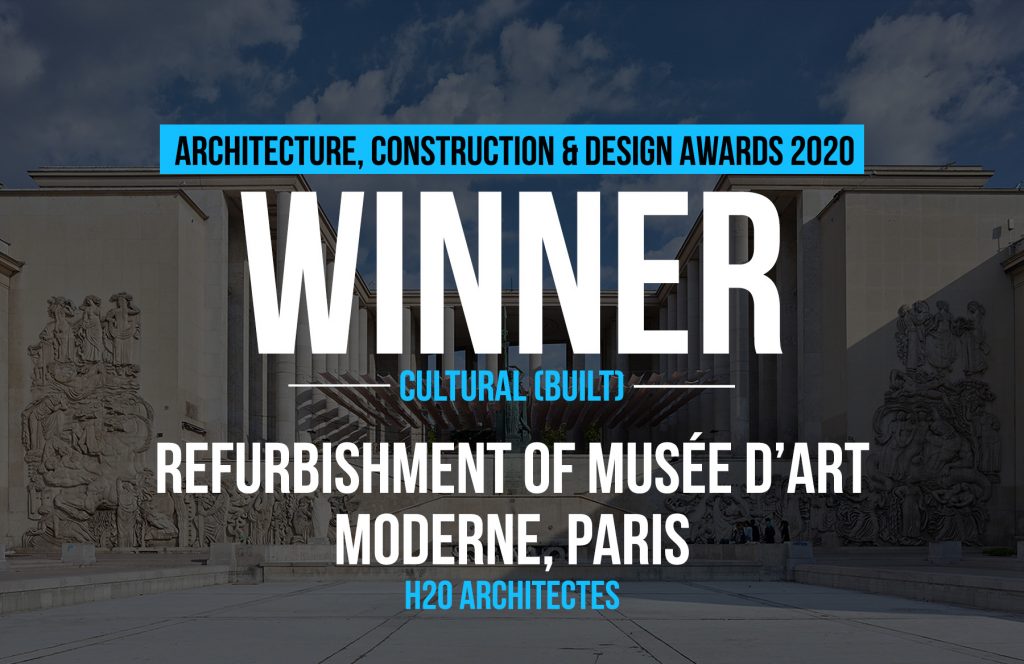The refurbishment project was carried out between July 2016 and October 2019. The brief was to improve the public reception area and the working environment.
Architecture, Construction & Design Awards 2020
First Award | Cultural (Built)
Project Name: Refurbishment of Musée d’Art Moderne, Paris
Studio Name: h2o architectes
Area: 21 000 m2
Year: 2019
Location: Paris, France
Consultants: studio GGSV (furnishing design), Equilibre structure (strucutural consultants), VPEAS (construction economist), GT2i (drainage consultant), Métronome (site organization and monitoring), Atelier On (lighting), Labeyrie (multimedia), Terrasol (geo-technician), Aubry & Guiguet (program), Risk & Co (health and public safety), Thierry Cames (fire safety coordination)
Photography Credits: Myr Muratet, Stéphane Chalmeau
We set out to consolidate the structure, enlarge some of the spaces, update some of the technical installations, and to create a connection between the various areas to give overall coherence to the museum. As the museum remained open to the public throughout the project, we had to complete the operation without disturbing visitors or staff. The refurbishment involved work on all floors and at every level, from relaying the foundations to the design of the furnishings and the signposting, and included demolition, decontamination, and creating new floors…
We wanted to open the museum out towards the city again. The entrance hall has been restored to its original volume; it is once again on the same scale as the forecourt and looks out onto it. The outside doors and windows have been reinstated to create a relationship between the inside of the building and the outside. The museum follows the natural topography of the site and wherever possible, we have accentuated the dynamic of this cascade down to the Seine. The new mezzanines in the entrance hall, for example, provide intersecting views and new perspectives that emphasize the stratification of the museum.
We have redesigned the facilities for the public and removed unnecessary past additions to restore the legibility of the spaces, to enable fluidity for the passage of people and to provide a design adapted to contemporary uses. We immersed ourselves in the original project and repeatedly tested it through proposals that we shared with the client to identify the most appropriate one. The extra reception areas, the restaurant, the repositioned facilities and the areas specifically reserved for staff, were integrated into the interstices of the museum. We exploited the behind-the-scenes areas of the building to make a clear distinction between those functions that the public would see and those that would be hidden from them.
While reserving room for future appropriation, we shaped the space to revitalize the reception area and make it easy to organize various events. The building has been redesigned to be permissive, flexible, characterized by “in-betweens”, dual uses and alternative situations. A host of small things, unexpected scheduling and clarifications of future use, gave substance to the project while leaving room for the unforeseen.
We had to engage with the vast scale of a building whose simplicity confers a generous neutrality on the artworks exhibited. The use of reinforced concrete had made it possible to create a sleek, elegant building. To give weight to the features of this architecture, the slender reinforced concrete framework was deliberately thickened out in 1937 with stone cladding, which gave the building its bulky, monumental character. We picked up on this clad architecture to enhance what already existed. The visible interventions are concentrated in the entrance hall, it brings back into view the topography of the site on which the building is built.
